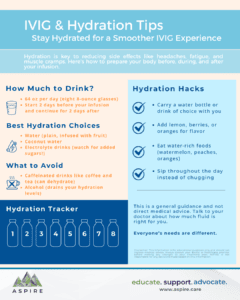Hydration & IVIG: Why It Matters
Staying well-hydrated before, during, and after IVIG can help minimize side effects like headaches, dizziness, fatigue, and muscle cramps. Here’s how to make hydration work for you:
Download ASPIRE’s IVIG & Hydration Tips
with Hydration Tracker
How Much to Drink
💧 Aim for 64 ounces (eight 8-ounce glasses) of fluids daily if you’re an adult.
💧 Start increasing your fluid intake at least two days before your infusion and continue for two days after.
Best Hydration Choices
✅ Water (plain or infused with fruit)
✅ Coconut water
✅ Electrolyte drinks (watch for added sugars!)
What to Avoid
❌ Caffeinated drinks like coffee and tea (can dehydrate)
❌ Alcohol (drains your hydration levels)
Helpful Tips for Staying Hydrated
✔ Track your intake – Use a journal or app to log your daily fluids.
✔ Carry water with you – Keep a bottle handy so you’re sipping throughout the day.
✔ Make it tasty – Add lemon, strawberries, or orange slices for natural flavor.
✔ Eat hydrating foods – Watermelon, oranges, peaches, and cucumbers all help boost hydration.
✔ Sip, don’t chug – Drinking consistently throughout the day is better than downing large amounts at once.
💡 This is a general guidance and not direct medical advice. Talk to your doctor about how much fluid is right for you. Everyone’s needs are different.
Additional ASPIRE Resources
Mastering the Art of Swallowing Pills: A Step-by-Step Guide
Struggling with pill swallowing can be tough, but you’re not alone. With the right techniques, it’s possible to make this part of treatment a little easier for everyone involved. Check out our step-by-step guide for practical tips to help patients and caregivers navigate this challenge. 💊
🔗 Mastering the Art of Swallowing Pills: A Step-by-Step Guide
Managing Needle Fear: Practical Tips for Blood Draws & Infusions
Needle fear is real, and you’re not alone. Whether it’s a quick blood draw or a longer infusion, the anxiety can be overwhelming. PANS/PANDAS symptoms can make this even tougher, but with the right strategies, it’s possible to make these experiences more manageable. Here are practical tips to help reduce stress and anxiety.
🔗 Managing Needle Fear: Practical Tips for Blood Draws & Infusions
Disclaimer: This information is for educational purposes only and should not replace medical advice. Always consult your doctor or healthcare provider before making any changes to your treatment plan. ASPIRE is not responsible for any decisions made based on this information.
